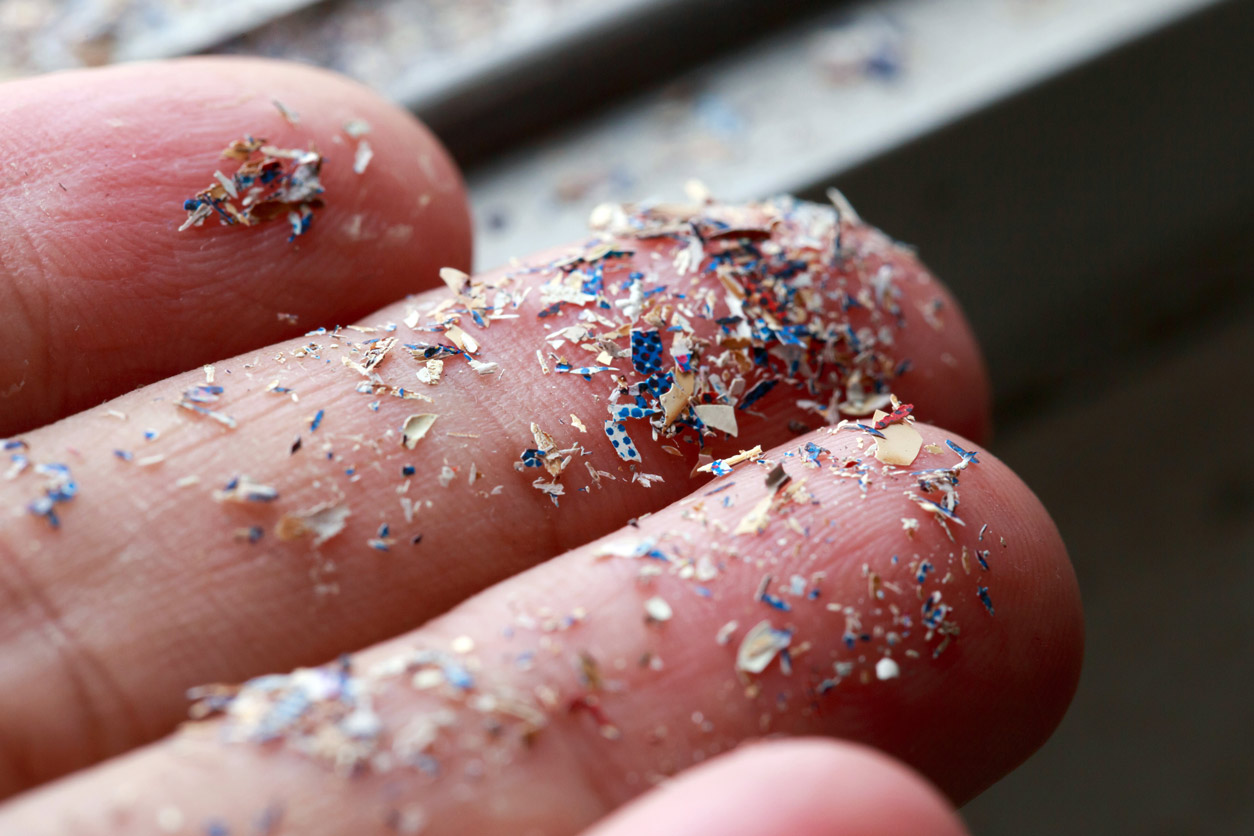More than 8 billion metric tons of plastics were produced globally between 1950 and 2015, according to one estimate. When plastics enter the environment or are used by consumers, tiny particles can break off and enter the human body through ingestion or inhalation. Research is needed to learn the extent of our exposure to these particles and how they may affect health.
Microplastics are smaller than 0.5 millimeters, or less than the size of a grain of rice. Even smaller are nanoplastics, which are the size of some viruses. Douglas Walker, Ph.D., an NIEHS grantee from Emory University, is working to expand knowledge about these particles.
In late April, during a symposium at the University of Brescia in Italy, he shared how he uses a framework known as exposomics to shed light on the human burden of exposure to microplastics and nanoplastics. (I delivered the keynote address at the event, which was supported in part by NIEHS and included other institute grantees.) Exposomics is the study of the exposome, which refers to the totality of environmental exposures experienced by people throughout life.
Thousands of chemicals are used in the production of plastics, according to Dr. Walker. Therefore, he aims to go beyond traditional research methods, which often focus on one substance or a relatively small number of compounds at a time. Walker develops exposomics tools to analyze real-world exposures to microplastics and nanoplastics, which involve many different chemicals.
Recently, I caught up with Dr. Walker to learn more about his research and how approaches he is advancing will lead to important scientific knowledge on microplastics and nanoplastics. I also asked him how people can try to avoid exposure to such particles and what inspired him to become a scientist in the first place. Excerpts of our interview are provided below.
Sources of exposure
Rick Woychik: What are sources of microplastics and nanoplastics?

Douglas Walker: These particles can form in secondary ways, meaning they can be shed when plastic materials are in the environment, in water, and so forth. There are also primary sources of microplastics, such as microbeads, which have been used in certain soaps and toothpastes.
Things like food packaging, soda bottles, tire wear, and emptying your dryer’s lint trap can result in exposure to microplastics. There is even a recent paper showing that the simple action of using a knife against a plastic cutting board potentially generates millions of these tiny particles. The bottom line is that there are many sources of microplastics and nanoplastics, and the examples I have shared are just a small sampling of what is out there.
Researchers, including members of my lab, have identified microplastics in placenta, stool, the lungs, breast milk, and blood. I am sure that as we continue to look in other tissues, we will likely be finding these plastic particles in there as well.
Thousands of chemicals linked to plastics
RW: What do we know about the potential health effects of these particles?
DW: Researchers currently do not have strong evidence that there are — or are not — effects. One reason for this lack of scientific knowledge is that it has been very difficult to measure and analyze microplastics and nanoplastics with traditional approaches.
That being said, there is a large body of evidence showing potential effects of exposure to additives and other components of plastics, such as bisphenol A and phthalates, which can disrupt the endocrine system. These additives are mixed with plastics to make them more functional or usable. Many plastic particles contain those additives, but there are many other additives used in the production of plastics. Not surprisingly, there is some evidence that microplastics and nanoplastics may act as an additional source of exposure to these plastic additives.
Perhaps most concerning is that when scientists recently attempted to catalog every chemical used in plastic manufacturing, they identified more than 10,000 unique compounds, and only a very small fraction of them have ever been evaluated for toxicity or potential health effects.
Tiny particles, big challenges
RW: You mentioned one of the challenges of studying microplastics and nanoplastics. Can you expand on that and discuss how your lab is working to overcome such research obstacles?
DW: We recognize two big challenges with trying to assess plastic exposures. The first is that historically, we have lacked methods that allow us to measure very small particles, such as nanoplastics. And the other challenge is the complexity of plastic exposures, and the difficulties in ensuring we are using proper approaches to avoid contamination of our samples with plastics when we are analyzing them.
As I mentioned, there are thousands of chemicals linked to plastics, and they can transform as they move in the environment, if they are heated, when they reach our gut, and so forth. We could be exposed to many thousands of different chemicals from microplastics, and those compounds may differ significantly depending on various internal and external factors.
This has led us to embrace the exposome framework and make sure our methods capture more of the complexity of microplastics. We are shifting away from using targeted approaches, where we seek to measure exposures X, Y, and Z and see how they are linked to a specific health outcome.
Instead, we are developing untargeted methods to screen for as many plastic-related chemicals and microplastic particles as possible — even ones we are not currently aware of — so that we can learn which exposures are most strongly associated with health outcomes we examine. We want to move beyond measuring a few chemicals at a time so that we can look for both known and completely unknown, or unexpected, exposures that may affect our health.
With that in mind, we are developing analytical strategies and research capabilities that merge high-resolution mass spectrometry techniques, computational workflows, and new biostatistical and data science approaches so that our work can be more robust and comprehensive.

Vision for microplastics research
RW: What are you focused on going forward?
DW: Microplastics exposure assessment should consider four elements, in my view. The first — and what I view as the most important — is to understand the overall burden of our exposures and their extent within human populations, which is what our team is focused on now. The second component deals with the fact that unlike chemicals, microplastics are discrete particles, and they may preferentially accumulate in certain tissues. The third element involves co-transportation of pollutants, such as the additives I mentioned earlier. And finally, we should assess the size and shape of particles and how those factors influence potential health effects. These should be combined with toxicological studies examining the impacts of the microplastics in cells and other models to understand if they could affect our health.
Innovation in exposomics
RW: How is your work advancing the relatively new field of exposomics?
DW: I view the exposome as being in a watershed moment, especially when you consider the technology that now makes it possible to develop comprehensive measurements of cumulative exposures. For example, my lab has improved the process of doing exposome screening, which has allowed us to analyze 20,000-plus samples per year using completely open-source and automated sample preparation methods and data processing approaches.
Now, we want to combine these efforts with other laboratories so that we can truly advance the ability to measure the exposome on a large scale, similar to what we are now capable of doing with genomics.
An effort that I think holds great promise involves developing what I call an exposome-disease atlas. Such a resource would aggregate multiple studies and disease outcomes and help scientists assess similarities and differences in exposures across populations and diseases.
Also, within the next two years, my team will have analyzed over 10,000 biological samples of people from cohorts all over the world who develop different blood cancers. And in another project, we will analyze about 12,000 samples from women who develop breast cancer and metabolic diseases. We hope to incorporate our findings into an exposome-disease atlas to begin unravelling the complex relationships between exposures and disease outcomes.
My colleagues and I are also excited to collaborate on a European Union project to examine the health impacts of early-life exposure to microplastics. We hope to build a comprehensive dataset examining plastic exposures in utero to better understand if these exposures could pose any risk to the developing fetus. When completed, this will be the largest dataset on human exposure to microplastics to date, and it will generate new insights into these exposures in humans.
Avoiding exposures
RW: How can people avoid exposure to microplastics and nanoplastics?
DW: I think it is very important to recognize that there are many benefits of plastics, so we should not view them as a net negative because they have completely changed how our world works, what we have access to, and so forth.
So, my recommendation is to be intentional about your plastic use. For example, if there is an opportunity to reuse a glass or metal bottle or maybe reuse silverware, that is not only potentially better for your own exposures but also better for our environment in terms of the massive amount of plastic waste that we produce as a society.
Rather than going to extremes and saying, “I’m going to try and avoid all plastics,” it is better to see where it is convenient or not too difficult to use something other than a single-use plastic.
Source link
factor.niehs.nih.gov

